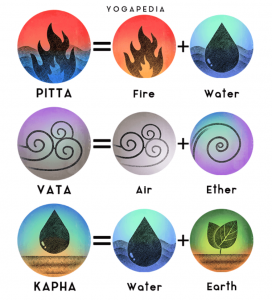Understanding and Implementing the Ayurvedic Doshas

Ayurveda, which translates as “knowledge of life,” dates back 5,000 years to the ancient Sanskrit texts, the Vedas. It’s a system of healing that examines physical constitution, emotional nature, and spiritual outlook in the context of the universe. According to the philosophy, universal life force manifests as three different energies, or doshas, known as vata, pitta, and kapha. We’re all made up of a unique combination of these three forces. Though everyone has some of each, most people tend to have an abundance of one or two of the doshas. This unique combination is determined at the moment of conception and is your own personal blueprint, or prakriti (nature). As you move through life, the proportion of each of the three doshas constantly fluctuates according to your environment, your diet, the seasons, the climate, your age, and many other factors. As they move into and out of balance, the doshas can affect your health, energy level, and general mood.
Understanding your doshic composition and how to best manage your diet, eating times, sleeping times, medical treatment, and overall care is necessary for living a balanced and happy life. Visit an Ayurvedic practitioner and find more research through trusted websites and yoga scriptures.
Read more about Ayurveda and Its Uses
What are the 3 Doshas?
Kapha
Kapha types have strong frames and are naturally athletic as long as they are exercising regularly to manage their tendency to gain weight. The influence of the earth and water elements makes them innately stable, compassionate, and loyal. They appreciate doing things in a methodical, step-by-step manner, and prefer a regular routine in their personal and professional lives. When imbalanced they can become unmotivated, stubborn, and complacent even when change is necessary. Their metabolism tends to be slow and their appetite for both food and stimulation is less intense than vata or pitta types. They benefit from exposing themselves to new environments, people, and occasionally fasting.
Pitta
Pitta types are dominated by the fire element, which makes them innately strong, intense, and irritable. They tend to have a medium build and endurance with powerful musculature. They often have freckled skin that easily reddens in the sun, during exercise, massage, and when blushing. They are strong willed and good at doing what they think is right. They approach work and play with the same intensity and competitiveness. They are natural leaders and quick learners whose ability to easily comprehend and master new skills and concepts can make them judgmental or impatient toward people they feel are slower or less focused than themselves. They have strong digestion and intense appetites, both for food and challenges. If they miss a meal they are likely to become grumpy and may take a “bite” out of somebody instead. It is common for them to suffer from health conditions such as inflammation, rashes, acne, and loose stool. For balance, pittas need to manage their “fiery” tendencies, channeling them in productive ways and learning to recognize their destructive power.
Vata
Vata types tend to be thin and lanky. They are very mentally and physically active and enjoy creative endeavors, meeting new people, and traveling to new places. When they are balanced, vatas are flexible, have lively imaginations, and are original thinkers. When imbalanced they can get anxious, ungrounded, and can seem “flaky” about fulfilling commitments, sticking to a routine, and completing projects. They tend to run cold and dry and enjoy warm, humid weather. It’s common for vata types to experience cold hands and feet, constipation, dry skin, and cracking joints. The influence of the air element in their constitution causes their energy, mood, and appetite to fluctuate dramatically. For this reason vata types often fail to eat and sleep regularly, swinging from eating heavy foods to ground and sedate themselves, or ingesting stimulants like coffee and sugar to sustain intense physical or mental activity. Insomnia and low immunity are very common problems for the sensitive vata person.
Your Constitution and Its Inner Balance
Ayurveda places great emphasis on prevention and encourages the maintenance of health through close attention to balance in one’s life, right thinking, diet, lifestyle and the use of herbs. Knowledge of Ayurveda enables one to understand how to create this balance of body, mind and consciousness according to one’s own individual constitution and how to make lifestyle changes to bring about and maintain this balance.
Just as everyone has a unique fingerprint, each person has a particular pattern of energy—an individual combination of physical, mental and emotional characteristics—which comprises their own constitution. This constitution is determined at conception by a number of factors and remains the same throughout one’s life.
Many factors, both internal and external, act upon us to disturb this balance and are reflected as a change in one’s constitution from the balanced state. Examples of these emotional and physical stresses include one’s emotional state, diet and food choices, seasons and weather, physical trauma, work and family relationships. Once these factors are understood, one can take appropriate actions to nullify or minimize their effects or eliminate the causes of imbalance and re-establish one’s original constitution. Balance is the natural order; imbalance is disorder. Health is order; disease is disorder. Within the body there is a constant interaction between order and disorder. When one understands the nature and structure of disorder, one can re-establish order.
Balancing the Three Principle Energies of the Body
Ayurveda identifies three basic types of energy or functional principles that are present in everyone and everything. Since there are no single words in English that convey these concepts, we use the original Sanskrit words vata, pitta and kapha. These principles can be related to the basic biology of the body.
Energy is required to create movement so that fluids and nutrients get to the cells, enabling the body to function. Energy is also required to metabolize the nutrients in the cells, and is called for to lubricate and maintain the structure of the cell. Vata is the energy of movement; pitta is the energy of digestion or metabolism and kapha, the energy of lubrication and structure. All people have the qualities of vata, pitta and kapha, but one is usually primary, one secondary and the third is usually least prominent. The cause of disease in Ayurveda is viewed as a lack of proper cellular function due to an excess or deficiency of vata, pitta or kapha. Disease can also be caused by the presence of toxins.
In Ayurveda, body, mind and consciousness work together in maintaining balance. They are simply viewed as different facets of one’s being. To learn how to balance the body, mind and consciousness requires an understanding of how vata, pitta and kapha work together. According to Ayurvedic philosophy the entire cosmos is an interplay of the energies of the five great elements—Space, Air, Fire, Water and Earth. Vata, pitta and kapha are combinations and permutations of these five elements that manifest as patterns present in all creation. In the physical body, vata is the subtle energy of movement, pitta the energy of digestion and metabolism, and kapha the energy that forms the body’s structure.
Vata is the subtle energy associated with movement — composed of Space and Air. It governs breathing, blinking, muscle and tissue movement, pulsation of the heart, and all movements in the cytoplasm and cell membranes. In balance, vata promotes creativity and flexibility. Out of balance, vata produces fear and anxiety.
Pitta expresses the body’s metabolic system — made up of Fire and Water. It governs digestion, absorption, assimilation, nutrition, metabolism and body temperature. In balance, pitta promotes understanding and intelligence. Out of balance, pitta arouses anger, hatred and jealousy.
Kapha is the energy that forms the body’s structure — bones, muscles, tendons — and provides the “glue” that holds the cells together, formed from Earth and Water. Kapha supplies the water for all bodily parts and systems. It lubricates joints, moisturizes the skin, and maintains immunity. In balance, kapha is expressed as love, calmness and forgiveness. Out of balance, it leads to attachment, greed and envy.
Life presents us with many challenges and opportunities. Although there is much over which we have little control, we do have the power to decide about some things, such as diet and lifestyle. To maintain balance and health, it is important to pay attention to these decisions. Diet and lifestyle appropriate to one’s individual constitution strengthen the body, mind and consciousness.
“Ayurveda Overview.” FoundHealth, www.foundhealth.com/ayurveda/overview.
“Ayurveda: A Brief Introduction and Guide.” The Ayurvedic Institute, www.ayurveda.com/resources/articles/ayurveda-a-brief-introduction-and-guide.
“Understanding the Doshas: An Intro to Ayurvedic Principles.” Yoga Journal, 6 Apr. 2021, www.yogajournal.com/lifestyle/health/intro-ayurveda/.
Join Our Community
Archives
- January 2023
- December 2022
- September 2022
- August 2022
- June 2022
- May 2022
- April 2022
- March 2022
- February 2022
- January 2022
- December 2021
- November 2021
- October 2021
- September 2021
- August 2021
- July 2021
- June 2021
- May 2021
- March 2021
- September 2020
- August 2020
- July 2020
- June 2020
- May 2020
- April 2020
- March 2020
- February 2020
Subscribe

Sign up to receive FREE toolkit
From Dr. Hyman, #1 NY Times & Amazon Author
We never spam or sell your e-mail






Follow Our Every Move